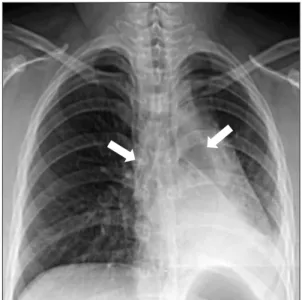Serious Complications after Self-expandable Metallic Stent Insertion in a Patient with
Malignant Lymphoma
Sung Bae Cho, M.D.
1, Seon Ah Cha, M.D.
1, Joon Young Choi, M.D.
1, Jong Min Lee, M.D.
1, Hyeon Hui Kang, M.D.
1, Hwa Sik Moon, M.D., Ph.D.
1, Sei Won Kim, M.D.
2, Chang Dong Yeo, M.D.
3and Sang Haak Lee, M.D., Ph.D.
11
Department of Internal Medicine, St. Paul’s Hospital, College of Medicine, The Catholic University of Korea, Seoul,
2Department of Internal Medicine, Yeouido St. Mary’s Hospital, College of Medicine, The Catholic University of Korea, Seoul,
3Department of Internal Medicine, Uijeongbu St. Mary’s Hospital, College of Medicine, The Catholic University of Korea, Uijeongbu, Korea
An 18-year-old woman was evaluated for a chronic productive cough and dyspnea. She was subsequently diagnosed with mediastinal non-Hodgkin lymphoma (NHL). A covered self-expandable metallic stent (SEMS) was implanted to relieve narrowing in for both main bronchi. The NHL went into complete remission after six chemotherapy cycles, but atelectasis developed in the left lower lobe 18 months after SEMS insertion. The left main bronchus was completely occluded by granulation tissue. However, the right main bronchus and intermedius bronchus were patent. Granulation tissue was observed adjacent to the SEMS. The granulation tissue and the SEMS were excised, and a silicone stent was successfully implanted using a rigid bronchoscope. SEMS is advantageous owing to its easy implantation, but there are considerable potential complications such as severe reactive granulation, stent rupture, and ventilation failure in serious cases. Therefore, SEMS should be avoided whenever possible in patients with benign airway disease. This case highlights that SEMS implantation should be avoided even in malignant airway obstruction cases if the underlying malignancy is curable.
Keywords: Airway Obstruction; Stents; Bronchoscopy; Granulation Tissue
Introduction
Airway obstruction has numerous causes and can induce serious clinical symptoms and disease such as dyspnea, hy- poxemia, obstructive pneumonia, or respiratory failure. Air- way stenting is a well-established method that immediately relieves symptoms and maintains airway patency in cases of inoperable airway obstruction
1-6. Currently, two stent types are used therapeutically, a self-expandable metallic stent (SEMS) and a silicone stent. SEMS is used to treat malignant airway obstructions because it can be easily placed by a flexible bron- choscope. However, SEMS may cause long-term complica- tions such as granulation tissue formation, and the incidence of complications increase over time
7,8. If the stent becomes obstructed by granulation tissue, then stent removal or other interventions are required, which themselves may cause seri- ous complications
9.
Copyright © 2015
The Korean Academy of Tuberculosis and Respiratory Diseases.
All rights reserved.
Address for correspondence: Sang Haak Lee, M.D., Ph.D.
Department of Internal Medicine, St. Paul’s Hospital, College of Medicine, The Catholic University of Korea, 180 Wangsan-ro, Dongdaemun-gu, Seoul 130-709, Korea
Phone: 82-2-961-4500, Fax: 82-2-968-7250 E-mail: agmante@gmail.com
Received: Aug. 6, 2014 Revised: Sep. 24, 2014 Accepted: Sep. 24, 2014
cc
